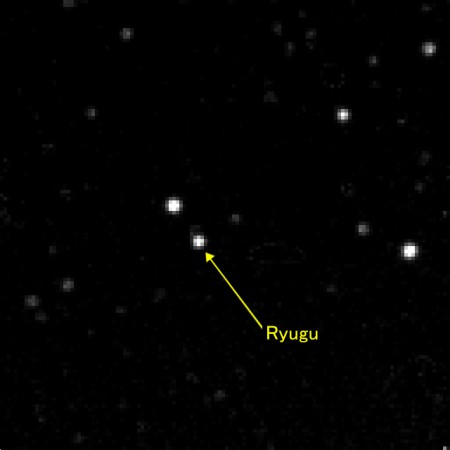
Japanese space program has just accomplished a great feat. In one of the coolest ever space missions, the country's Hayabusa 2 space probe reached its destination and successfully deployed two landers on the surface of asteroid Ryugu. Soon after the probe itself will touch down the soil of the asteroid and bring back some samples of Ryugu to Earth.
As surprising as it sounds but asteroid mining is not a new thing anymore. Hayabusa 1 was also an asteroid sampling probe and as the name suggests Hayabusa 2 is its successor. This one packs in more hi-tech equipment and also it is scheduled to stay longer at the destination than its predecessor.
Situated in an orbit between the Earth and Mars, the asteroid Ryugu is believed to be rich in water and organic materials, making it a perfect object for learning more about the possible extraterrestrial societies in the galaxy and maybe, other solar systems.
The probe was launched from Earth in 2014.
The two "MINERVA" landers, which the probe deployed on the asteroid, have already made contact with the mother ship and sent back home some amazing pictures as well. They will also test the asteroid's temperature and investigate the places that they land on.
More than the landers, the bigger news is expected to come next year when Hayabusa 2 itself will land on the surface of Ryugu with its "small carry-on impactor." This instrument will dig a hole on the asteroid and collect the sample from below Ryugu's surface and bring it to Earth.
In the past, NASA and ESA have successfully sent exploration missions to asteroids, starting from NASA's Galileo in 1989 that flew past and took images of asteroid Gaspra in 1991, and then asteroid Ida two years later in 1993. Next, the Clementine spacecraft, launched in 1994, successfully completed the lunar portion of the mission though it faced technical problems on its way Geographos.
NASA's NEAR-Shoemaker, launched in 1996, closely flew past asteroid Mathilde, coming within 1212 km of the asteroid's surface, next year. On 14 February 2000, NEAR settled into orbit around its primary target Eros, and touched down on the asteroid's surface in February 2001, transmitting close-up images as it descended.
In 1997, the NASA/ESA/ASI Cassini-Huygens mission to Saturn passed by the asteroid belt en route to Saturn, and took images of asteroid Masursky. NASA's next mission Deep Space 1, launched in 1998, flew by asteroid Braille, coming within just 26 km of its surface.
Other notable asteroid missions include ESA's Rosetta, launched in 2004 that performed two asteroid flybys: Steins in September 2008, and Lutetia in July 2010, before reaching its primary target, Comet 67P/Churyumov-Gerasimenko in August 2014.
China's Chang'e 2, launched in 2010, is currently journeying towards asteroid Toutatis on an extended mission. currently, it is 70 million km from Earth.









